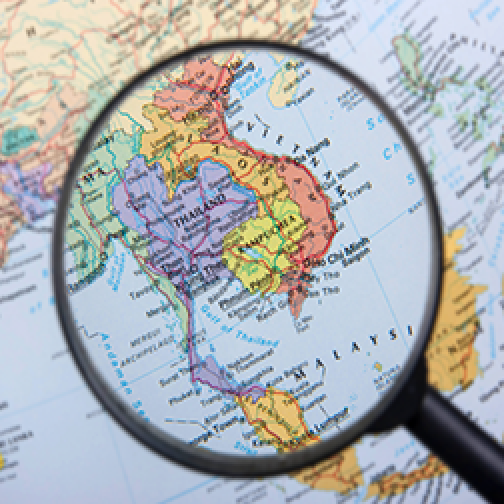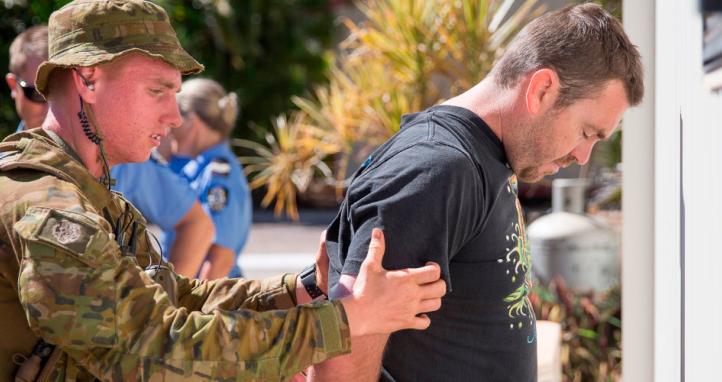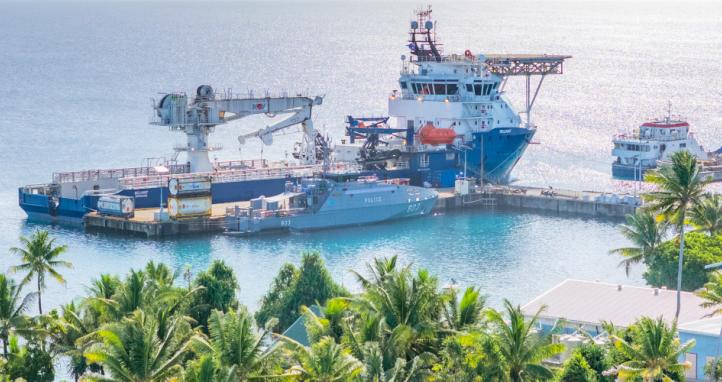Facts and figures
The ‘Know Your Region’ series is designed to support unit and individual professional military education on the Indo-Pacific region. It’s important for all serving members of our military to have a foundational knowledge of the countries and issues in the Indo-Pacific.
On this page:
- Tuvalu’s Climate Crisis – Summary
- Government Response to Climate Change
- The Tuvalu Coastal Adaptation Project (TCAP)
- Legal Responses
- Constitutional amendment to protect state continuity
- Disaster law, land tenure and local governance
- Migration as adaptation
- Partnerships and advocacy
Tuvalu’s Climate Crisis
Summary
Tuvalu’s total land area is only 26 square kilometres, with the highest natural elevation barely a few metres above sea level. Its settlements, especially the capital Funafuti, sit on low-lying reef-islands with narrow strips of buildable land. These physical characteristics mean even small increases in mean sea level and storm surge height translate quickly into widespread destruction, saltwater intrusion of groundwater, erosion of shorelines, loss of agricultural soils, and damage to infrastructure (homes, roads, the airport runway and utilities). Long-term climate forecasts coupled with local monitoring show persistent increases in the frequency and depth of coastal inundation events.

Tuvalu Low-lying atolls – Defence Image Library
Tuvalu is now experiencing regular “king tides” (periodic extreme high tides) flooding areas that were previously not affected. In early 2024, king tides began to inundate parts of Funafuti and outer islands, flooding homes, contaminating water supplies, and depositing debris and rock onto roads. Repeated repairs are expensive and have diverted scarce government funds from development priorities.
Ongoing coastal erosion has narrowed beaches and, in places, removed strips of habitable land. Reef and beach erosion has also damaged cultural sites and vegetation belts that buffer communities from wave action. Some reclamation efforts have temporarily created higher ground, but erosion is an ongoing maintenance challenge.
Saltwater has infiltrated shallow freshwater lenses (Tuvalu’s primary freshwater source for drinking and irrigation), especially after prolonged high tides or storm surges. Contaminated wells have forced households to rely on rainwater harvesting (which is seasonal) or imported water. Damage to crops such as taro, breadfruit, and pandanus has reduced food security and increased reliance on imported staples.
The effects of climate change have been profound for the local population. People have moved away from the outer islands to the main island of Funafuti, which has caused over-crowding. Reduced fish stock has affected livelihoods, and mental health has declined as people are confronted with repeated loss and uncertainty about long-term options.
Government Response to Climate Change
The government of Tuvalu has acknowledged that climate change is the most pressing existential threat facing the country. Most domestic and foreign policy decisions revolve around addressing both the short- and long-term risks associated with rising sea levels and extreme weather events.
The Tuvalu Coastal Adaptation Project (TCAP)
The Tuvalu Coastal Adaptation Project (TCAP) is the government's flagship multi-island adaptation programme. Launched with financing from the Green Climate Fund (GCF), Tuvalu development funds, and bilateral partners; TCAP supports large coastal protection works (bunded reclamations, breakwaters and boat harbours), beach nourishment, and community resilience measures on Funafuti and selected outer islands. The project blends engineered works with ecosystem approaches, such as the planting of mangroves to protect against coastal erosion. It also includes capacity-building and community engagement components. In late 2024, TCAP celebrated the official handover of several hectares of reclaimed, elevated land to the Government of Tuvalu – a significant milestone for the project.
TCAP is not a permanent solution if sea-levels continue to rise, but it is the primary way to maintain habitability and reduce short- to medium-term displacement risk. It is designed to buy time for communities; protect critical infrastructure including schools, clinics, roads, and the small airport precinct; and create space for emergency shelters and the relocation of sensitive assets.
National and island authorities have strengthened early-warning systems, emergency evacuation routes, and community resilience training. Investments in rainwater harvesting, cisterns, and improved water management are helping to reduce freshwater shortages triggered by saltwater intrusion.
Legal Responses
Constitutional amendment to protect state continuity
In 2023 Tuvalu amended its Constitution to assert that “the State of Tuvalu within its historical, cultural and legal framework shall remain in perpetuity…notwithstanding the impacts of climate change or other causes resulting in loss to the physical territory of Tuvalu.” This landmark reform is designed to preserve Tuvalu’s international legal personality, citizenship, and maritime entitlements even if physical territory is lost. The amendment is symbolic and practical. It aims to attain international protections and to secure the legal basis for claims tied to state continuity.
Disaster law, land tenure, and local governance
Tuvalu’s laws and falekaupule mechanisms have been adapted to manage relocation, emergency response, and allocation of reclaimed land. Land tenure is complex (customary ownership dominates), and any internal relocation must balance customary land claims with urgent protection needs, which requires careful community consultation.
Migration as adaptation
Tuvalu recognises migration as an adaptation strategy and has pursued bilateral mobility pathways to protect citizens’ rights while preserving Tuvaluan identity.
In late 2023 and into 2024 Tuvalu and Australia negotiated the Falepili Union, a novel bilateral pact that combines climate cooperation, security assistance, and a mobility package that allows up to 280 Tuvaluans to migrate to Australia per year. The pact is notable because it is one of the first bilateral arrangements explicitly linking climate vulnerability to mobility, and because it provides a legal, dignified pathway that complements in-country adaptation efforts. Australia also pledged significant financial and practical support for adaptation projects and emergency assistance.
Planned migration poses social and cultural dilemmas. Some of these include - preserving the local language, dealing with land claims, maintaining customary practices and political identity among dispersed populations, ensuring equitable selection criteria for migrants, preventing brain-drain, and providing social services for migrants in receiving countries.
Partnerships and advocacy
Scientific partnerships (for example NASA’s sea-level research and UN technical support) provide data and modelling that inform local planning: projections of coastal inundation, assessments of island morphology, and mapping of areas likely to be flooded by 2050-2100. This research is essential for TCAP designs, coastal hazard zoning, and legal claims about future impacts.
Engineering works can protect specific assets but is costly, requires maintenance, and can damage reefs and sediment flows. Nature-based solutions are valuable but may fail under extreme sea-level rise. While every effort is helpful, there is a real limit as to how far adaptation measures can go. Tuvalu has become a leading voice at the United Nations advocating for stronger climate protection policies and legal rights for nations at risk. While there are contingencies in place, Tuvalu’s future is very uncertain.
For more information on Tuvalu’s climate crisis, see the resources below:
Videos
- Tuvalu is disappearing due to climate change and locals are moving to Australia | 7.30
- Tuvalu: Living on borrowed time and shaky foundations
- Sinking Paradise The Untold Story Of Tuvalu’S Fight To Stay Afloat – YouTube
- Tuvalu’s doom: When an entire country goes underwater
- Tuvalu’s Land Makers | Beyond Awesome | ABC Australia
Articles
- Tuvaluans prepare for life in Australia as rising tides swallow their country - ABC News
- Tuvalu Coastal Adaptation Project
- NASA-UN Partnership Gauges Sea Level Threat to Tuvalu – NASA Sea Level Change Portal
- The bittersweet offer of Australia for some Tuvalu citizens | SBS News
- Tuvalu and Partners Deliver Landmark Coastal Adaptation Project Creating New Land for the Future | United Nations Development Programme
- Tuvalu: Why Is the Small Island Nation Sinking? | Earth.Org
- A World-First Climate Visa: Tuvalu’s Lifeline Amid Rising Seas - Climate Fact Checks
- Rising Tides, Rising Solutions: Tuvalu’s Innovative Climate Adaptation Strategies – The Diplomat
Know your region
Know Your Region series gives you a shortcut to understanding other nations in the Indo-Pacific region.










Far from 'doing an Atlantis' Tuvalu is growing! "However, over four decades, there had been a net increase in land area of the islets of 0.74 square kilometres (0.3 square miles) (2.9%), although the changes are not uniform, with 74% increasing and 27% decreasing in size. A 2018 report stated that the rising sea levels are identified as creating an increased transfer of wave energy across reef surfaces, which shifts sand, resulting in accretion to island shorelines."
The salination is caused by over-extraction of fresh water allowing salt water to 'invade' the reservoirs. Pollution and over-exploitation of fishing are man-made problems the good engineering and good management can control. Much easier to blame the 'climate' and stick out the alms bowl ...